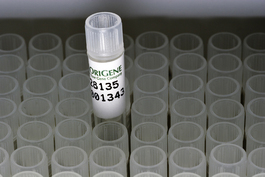GPR136 (OPN5) (NM_001030051) Human Untagged Clone
CAT#: SC302502
OPN5 (untagged)-Human opsin 5 (OPN5), transcript variant 2
Product Images

Other products for "OPN5"
Specifications
| Product Data | |
| Type | Human Untagged Clone |
| Tag | Tag Free |
| Symbol | OPN5 |
| Synonyms | NEUROPSIN; opsin 5; OTTHUMP00000016565; OTTHUMP00000039910; PGR12; TMEM13; transmembrane protein 13 |
| Vector | PCMV6-Neo |
| E. coli Selection | Ampicillin (100 ug/mL) |
| Mammalian Cell Selection | Neomycin |
| Sequence Data |
>NCBI ORF sequence for NM_001030051, the custom clone sequence may differ by one or more nucleotides
ATGCCCTTGGTAGGTCTGGGGGACTACGTACCTGAGCCCTTCGGAACCTCGTGCACCCTG GACTGGTGGCTGGCCCAGGCCTCGGTAGGGGGCCAGGTTTTCATCCTGAACATCCTCTTC TTCTGCCTCTTGCTCCCAACGGCTGTGATCGTGTTCTCCTACGTAAAGATCATTGCCAAG GTTAAGTCCTCTTCCAAAGAAGTAGCTCATTTCGACAGTCGGATCCATAGCAGCCATGTG CTGGAAATGAAACTGACAAAGGTAGCGATGTTGATTTGTGCTGGATTCCTGATTGCCTGG ATTCCTTATGCAGTGGTGTCTGTGTGGTCAGCTTTTGGAAGGCCAGACTCCATTCCCATA CAGCTCTCTGTGGTGCCAACCCTACTTGCAAAATCTGCAGCGATGTACAATCCCATCATT TACCAAGTTATTGATTACAAATTTGCCTGTTGCCAAACTGGTGGTTTGAAAGCAACCAAG AAGAAGTCTCTGGAAGGCTTCAGGCTGCACACCGTAACCACAGTCAGGAAGTCTTCTGCT GTGCTGGAAATTCATGAAGAGTGGGAATAA |
| Restriction Sites | Please inquire |
| ACCN | NM_001030051 |
| OTI Disclaimer | Due to the inherent nature of this plasmid, standard methods to replicate additional amounts of DNA in E. coli are highly likely to result in mutations and/or rearrangements. Therefore, OriGene does not guarantee the capability to replicate this plasmid DNA. Additional amounts of DNA can be purchased from OriGene with batch-specific, full-sequence verification at a reduced cost. Please contact our customer care team at custsupport@origene.com or by calling 301.340.3188 option 3 for pricing and delivery. The molecular sequence of this clone aligns with the gene accession number as a point of reference only. However, individual transcript sequences of the same gene can differ through naturally occurring variations (e.g. polymorphisms), each with its own valid existence. This clone is substantially in agreement with the reference, but a complete review of all prevailing variants is recommended prior to use. More info |
| OTI Annotation | This TrueClone is provided through our Custom Cloning Process that includes sub-cloning into OriGene's pCMV6 vector and full sequencing to provide a non-variant match to the expected reference without frameshifts, and is delivered as lyophilized plasmid DNA. |
| Product Components | The cDNA clone is shipped in a 2-D bar-coded Matrix tube as dried plasmid DNA. The package also includes 100 pmols of both the corresponding 5' and 3' vector primers in separate vials. Every lot of primer is tested to provide clean sequencing of OriGene TrueClones. |
| Reconstitution | 1. Centrifuge at 5,000xg for 5min. 2. Carefully open the tube and add 100ul of sterile water to dissolve the DNA. 3. Close the tube and incubate for 10 minutes at room temperature. 4. Briefly vortex the tube and then do a quick spin (less than 5000xg) to concentrate the liquid at the bottom. 5. Store the suspended plasmid at -20°C. The DNA is stable for at least one year from date of shipping when stored at -20°C. |
| Reference Data | |
| RefSeq | NM_001030051.1, NP_001025222.1 |
| RefSeq Size | 3455 bp |
| RefSeq ORF | 570 bp |
| Locus ID | 221391 |
| Cytogenetics | 6p12.3 |
| Protein Families | Druggable Genome, Transmembrane |
| Gene Summary | Opsins are members of the guanine nucleotide-binding protein (G protein)-coupled receptor superfamily. This opsin gene is expressed in the eye, brain, testes, and spinal cord. This gene belongs to the seven-exon subfamily of mammalian opsin genes that includes peropsin (RRH) and retinal G protein coupled receptor (RGR). Like these other seven-exon opsin genes, this family member may encode a protein with photoisomerase activity. Alternative splicing results in multiple transcript variants. [provided by RefSeq, Jun 2010] Transcript Variant: This variant (2) has multiple differences in the presence and absence of exons at its 5' end, compared to variant 1. These differences produce a unique 5' UTR and cause translation initiation at a downstream start codon, compared to variant 1. The encoded protein (isoform 2) is shorter than isoform 1. |
Documents
| Product Manuals |
| FAQs |
Resources
{0} Product Review(s)
0 Product Review(s)
Submit review
Be the first one to submit a review
Product Citations
*Delivery time may vary from web posted schedule. Occasional delays may occur due to unforeseen
complexities in the preparation of your product. International customers may expect an additional 1-2 weeks
in shipping.






























































































































































































































































 Germany
Germany
 Japan
Japan
 United Kingdom
United Kingdom
 China
China
